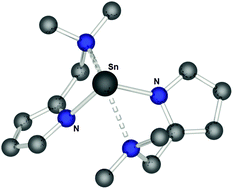Synthesis, characterisation and thermal properties of Sn(ii) pyrrolide complexes†
Abstract
SnO is a rare example of a stable p-type semiconductor material. Here, we describe the synthesis and characterisation of a family of Sn(II) pyrrolide complexes for future application in the MOCVD and ALD of tin containing thin films. Reaction of the Sn(II) amide complex, [{(Me3Si)2N}2Sn], with the N,N-bidentate pyrrole pro-ligand, L1H, forms the hetero- and homoleptic complexes [{L1}Sn{N(SiMe3)2}] (1) and [{L1}2Sn] (2), respectively, bearing the 2-dimethylaminomethyl-pyrrolide ligand (L1). Reaction of [{(Me3Si)2N)}2Sn] with the pyrrole-aldimine pro-ligands, L2H–L7H, results in the exclusive formation of the homoleptic bis-pyrrolide complexes [{L2–7}2Sn] (3–8). All complexes have been characterised by elemental analysis and NMR spectroscopy, and the molecular structures of complexes 1–5 and 8 are determined by single crystal X-ray diffraction. TG analysis and isothermal TG analysis have been used to evaluate the potential utility of these systems as MOCVD and ALD precursors.

- This article is part of the themed collection: Philip Power at 65: an icon of organometallic chemistry


 Please wait while we load your content...
Please wait while we load your content...